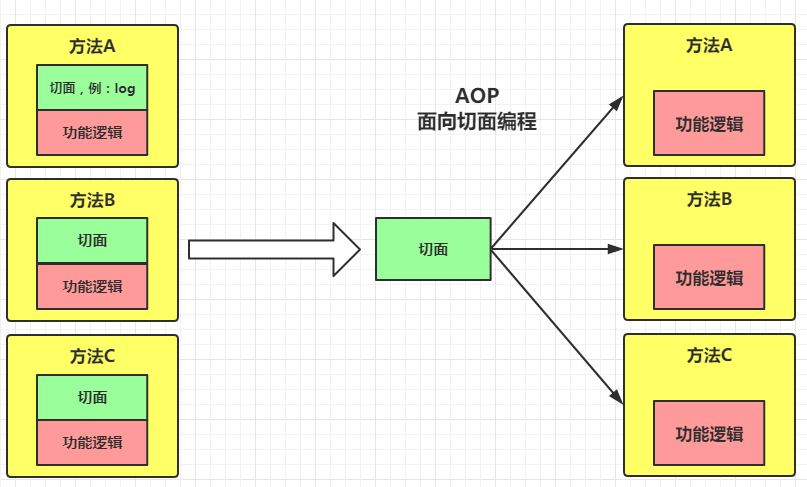简介
Spring框架是一个容器,是整合其他框架的框架
他的核心是IOC(控制反转)和AOP(面向切面编程),由20多个模块构成,在很多领域都提供了优秀的问题解决方案
特点
-
轻量级:由20多个模块构成,每个jar包都很小,小于1M,核心包也就3M左右
-
代码污染小:Spring框架对程序员开发时的条条框框的约束较少,对代码的污染小
-
面向接口编程:面向接口编程,灵活性高,项目的可扩展性和可维护性都较高
-
AOP:面向切面编程,将公共的,通用的,重复的代码单独开发,在需要时反织回去
-
示例:

示例分析:在开发中普遍需要使用到日志输出功能,会将日志输出功能大量耦合到项目的不同位置,如上图左侧所示。
而日志输出功能与项目本身的核心业务逻辑无关,我们只是为了不时的查看程序的运行状态。则可以将日志功能单独提出去开发,在需要的地方将日志输出功能(所谓:切面)反织回去即可,如上图右侧所示。
- 整合其他框架:使其他框架也更加易用
IOC
- IOC(Inversion of Control):是一个概念,也是一种思想,由Spring容器进行对象的创建和依赖注入,程序员在使用时直接取用即可
- 正转示例
//程序员创建对象
Student stu = new Student();
//程序员进行赋值
stu.setName("荷包蛋");
stu.setAge(20);
- 反转示例
<bean id="stu" class="com.example.pojo.Student">
<property name="name" value="荷包蛋" />
<property name="age" value="20" />
bean>
创建Spring项目
- 创建maven的java项目:模板类型 + 项目目录结构 + 修改pom.xml文件添加基本配置的操作不再赘述,可以参考mybatis博客集里对maven项目的配置
- 在pom.xml里添加Spring依赖
<dependency>
<groupId>org.springframeworkgroupId>
<artifactId>spring-contextartifactId>
<version>5.3.22version>
dependency>
- 在src/main/resources目录下添加Spring配置文件:applicationContext.xml,正常情况下,文件头自动补全(在下图状态下,无法截图,手机拍摄,包涵包涵)


创建实例对象
- 容器创建实例对象和传统方式下手动创建实例对象的对比
//实体类
package com.example.pojo;
public class Student {
private String name;
private int age;
public Student() {
System.out.println("无参方法被调用,Student实例被创建.....");
}
@Override
public String toString() {
return "Student{" +
"name='" + name + '\'' +
", age=" + age +
'}';
}
}
<beans xmlns="http://www.springframework.org/schema/beans"
xmlns:xsi="http://www.w3.org/2001/XMLSchema-instance"
xsi:schemaLocation="http://www.springframework.org/schema/beans http://www.springframework.org/schema/beans/spring-beans.xsd">
<bean id="stu" class="com.example.pojo.Student"/>
beans>
//两种创建实例对象的对比
package com.example.test;
import com.example.pojo.Student;
import org.junit.Test;
import org.springframework.context.ApplicationContext;
import org.springframework.context.support.ClassPathXmlApplicationContext;
public class TestStudent {
//测试程序员手动创建实例对象
@Test
public void testStudent(){
Student stu = new Student();
System.out.println(stu);
}
//测试Spring容器创建实例对象
@Test
public void testStudentSpring(){
//创建Spring容器,并启动
ApplicationContext applicationContext = new ClassPathXmlApplicationContext("applicationContext.xml");
//从容器中获取对象
Student stu = (Student) applicationContext.getBean("stu");
System.out.println(stu);
}
}
//两次测试的输出结果均为
无参方法被调用,Student实例被创建.....
Student{name='null', age=0}
Process finished with exit code 0
- 当Spring容器创建时,对应的应用域中注册的对象就会被创建
@Test
public void testStudentSpring(){
//创建Spring容器
ApplicationContext applicationContext = new ClassPathXmlApplicationContext("source01/applicationContext.xml");
}
//测试输出结果
无参方法被调用,Student实例被创建.....
Process finished with exit code 0
基于xml的IOC(控制反转)
setter注入
1. 简单类型(8 + 1)注入
- 使用value属性
//添加两个属性的set方法
public void setName(String name) {
this.name = name;
}
public void setAge(int age) {
this.age = age;
}
<bean id="stu" class="com.example.pojo.Student">
<property name="name" value="荷包蛋"/>
<property name="age" value="20"/>
bean>
//测试Spring容器创建实例对象
@Test
public void testStudentSpring(){
//创建Spring容器,并启动
ApplicationContext applicationContext = new ClassPathXmlApplicationContext("source01/applicationContext.xml");
//从容器中获取对象
Student stu = (Student) applicationContext.getBean("stu");
System.out.println(stu);
}
//测试输出:
无参方法被调用,Student实例被创建.....
Student{name='荷包蛋', age=20}
Process finished with exit code 0
2. 引用类型注入
- 使用ref属性
//School类
private String name;
private String address;
public void setName(String name) {
this.name = name;
}
public void setAddress(String address) {
this.address = address;
}
public School() {
System.out.println("School类的构造方法被执行,实体对象被创建.....");
}
@Override
public String toString() {
return "School{" +
"name='" + name + '\'' +
", address='" + address + '\'' +
'}';
}
- 新增实体类:School
//Student类
private String name;
private int age;
private School school;
public Student() {
System.out.println("Student类的构造方法执行,实体对象被创建....");
}
public void setName(String name) {
this.name = name;
}
public void setAge(int age) {
this.age = age;
}
public void setSchool(School school) {
this.school = school;
}
@Override
public String toString() {
return "Student{" +
"name='" + name + '\'' +
", age=" + age +
", school=" + school +
'}';
}
- Student对象持有School对象的引用
<bean id="school" class="com.example.pojo02.School">
<property name="name" value="nefu"/>
<property name="address" value="哈尔滨"/>
bean>
<bean id="stu" class="com.example.pojo02.Student">
<property name="name" value="荷包蛋"/>
<property name="age" value="20"/>
<property name="school" ref="school"/>
bean>
- 对于Student对象持有的School对象的引用,根据bean工厂中注册过的对象(不分注册先后),进行依赖注入(待注入属性类型必须和已经注册过的对象的类型一致,才可进行依赖注入)
//测试setter注入法的ref属性 @Test public void testStudent(){ //创建Spring容器,同时生成bean工厂中注册的对象 ApplicationContext applicationContext = new ClassPathXmlApplicationContext("source02/applicationContext.xml"); //获取对象 Student stu = (Student) applicationContext.getBean("stu"); System.out.println(stu); } - 创建Spring容器并获取对象,打印输出
//测试输出结果 School类的构造方法被执行,实体对象被创建..... Student类的构造方法执行,实体对象被创建.... Student{name='荷包蛋', age=20, school=School{name='nefu', address='哈尔滨'}} Process finished with exit code 0 - 进一步验证在创建容器时,注册过的对象就被创建,且普通类型的数据和引用类型的数据都正确注入
注意
- 使用setter注入法必须提供无参构造方法,必须提供待注入属性的setXXX()方法,简单分析如下:
- 无参构造方法用于创建实例对象,此时实例对象的属性是一张白纸,未被赋值和其他数据污染
- 对应属性的set方法是为了在底层调用时给目标属性赋值用,框架再封装,底层的执行代码该有的还要有,框架也不知道你在set方法中都想干些什么(毕竟set方法应该被用来赋值,但是不仅仅只能做赋值用)
- 有了前两步,你便可以得到需要的对象,而且只有指定的属性被赋值,其他属性一尘不染
- 但是,如果提供了有参构造方法,或者没有set方法,setter注入将会遇到无限多的麻烦
- 无set方法,底层无法调用对应set方法完成属性赋值
- 有参构造方法的参数会扰乱我们对指定属性的赋值计划
- 例如,有参构造包括name和age两个属性,而set又要对name属性注入值,就会导致name属性被两次赋值,在创建对象时就这样做显然不合理
- 所以,我们要做的就是,先创建一个干净的对象(无参构造,先不涉及属性值的问题),再用对应属性的set方法给属性赋值,做到精准赋值,按需操作